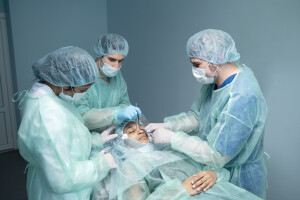When it comes to transforming your appearance through a nose job, or rhinoplasty, one of the most crucial considerations is the cost. While achieving the nose you desire is undoubtedly an exciting prospect, understanding the expenses involved is essential for effective budgeting and planning. In this comprehensive guide, we will delve into the intricacies of nose job cost, ensuring that you are well informed and prepared for this transformative journey.
Understanding the Components of Nose Job Cost
The cost of a nose job can vary significantly depending on various factors. Let’s break down the key components that contribute to the overall expense:
Surgeon’s Fee
The surgeon’s fee is a significant part of the cost, reflecting their expertise, experience, and reputation. Highly skilled and renowned surgeons often charge higher fees. However, choosing a qualified surgeon is paramount to achieving the best results and minimizing potential risks.
Anesthesia Fee
During a rhinoplasty, anesthesia is administered to ensure your comfort and safety throughout the procedure. The cost of anesthesia will vary based on the type used and the duration of your surgery.
Facility Fee
The surgical facility where the procedure takes place will have its own fee. This fee covers the use of the operating room, equipment, and support staff.
Pre-Operative and Post-Operative Expenses
Before and after your rhinoplasty procedure, there are essential expenses to consider. These costs contribute to the overall investment in achieving your desired outcome:
Pre-Operative Consultations: Prior to your surgery, you will typically have one or more consultations with your surgeon. During these appointments, your surgeon will assess your specific needs, discuss your goals, and plan the procedure. These consultations may involve fees.
Medical Tests: Depending on your health and medical history, your surgeon may require you to undergo various medical tests, such as blood tests or imaging. These tests are essential to ensure your safety during surgery and may incur additional expenses.
. Imaging and Photography: In some cases, surgeons use imaging technology to create a 3D model of your nose, allowing you to visualize potential outcomes. This technology may involve additional costs.
. Prescription Medications: After the surgery, you will likely receive prescriptions for pain relief, antibiotics, and other medications. These medications are necessary for your comfort and to prevent infections.
Post-Operative Appointments: Following your rhinoplasty, you will have several post-operative appointments with your surgeon to monitor your healing progress. These appointments are vital and may involve associated fees.
Additional Treatments: Depending on your unique case, you may require supplementary treatments such as dermal fillers or Botox to complement the results of your rhinoplasty. These treatments come with their own cost considerations.
It’s essential to discuss these pre-operative and post-operative expenses with your surgeon during your initial consultation. This transparency will help you budget effectively and ensure that there are no unexpected financial surprises during your rhinoplasty journey.
Geographic Location
The location of your chosen surgeon and surgical facility can significantly impact the overall cost. Major metropolitan areas often have higher living costs, which can translate to higher medical expenses.
Revision Surgery
In some cases, a revision rhinoplasty may be necessary to achieve the desired results or address any complications. It’s important to consider the potential need for revision surgery when budgeting.
Factors Affecting Nose Job Cost
Several factors can influence the cost of your nose job:
Type of Rhinoplasty
The extent and complexity of the rhinoplasty procedure will play a role in the cost. Cosmetic rhinoplasty may be less expensive than a procedure that also addresses functional issues.
Surgeon’s Experience
Highly experienced surgeons may command higher fees due to their skill and track record of successful surgeries.
Surgical Facility
The choice of a surgical facility, such as a hospital or an accredited outpatient surgical center, can impact the cost.
Location
Geographic variations in living costs can affect surgeon’s fees and facility charges.
Budgeting for Your Nose Job
Now that we’ve explored the various components and factors influencing nose job cost, it’s time to discuss how to budget effectively for this transformative procedure:
Consultation with Surgeon
The first step in budgeting is to schedule a consultation with a qualified rhinoplasty surgeon. During this consultation, you will receive an estimate of the total cost based on your specific needs and goals.
Financing Options
Many clinics offer financing options to make rhinoplasty more accessible. Explore these options and determine a payment plan that aligns with your budget.
Consider Long-Term Benefits
While the initial cost of a nose job may seem significant, it’s essential to consider the long-term benefits. Rhinoplasty can enhance your self-confidence and overall quality of life, making it a valuable investment in your well-being.
Plan for Additional Expenses
When budgeting for your rhinoplasty, it’s wise to consider potential additional expenses that may arise throughout your journey. While the primary cost components have been discussed, there are some unforeseen or optional expenses to keep in mind:
Time off Work: Depending on your occupation, you may need to take time off work to allow for a comfortable and stress-free recovery. Consider the potential loss of income during this period.
Travel and Accommodation: If you’re traveling to a different city or country for your rhinoplasty, factor in travel expenses, including transportation, lodging, and meals.
Unexpected Costs: While complications are rare, it’s prudent to set aside a contingency fund for any unforeseen medical expenses that may arise during or after your surgery.
Revision Surgery: In some cases, individuals opt for revision rhinoplasty to achieve their desired results or address any issues that may arise during the healing process. Be prepared for the possibility of additional surgery and its associated costs.
Scar Management: If scarring is a concern for you, you may choose to invest in scar management treatments or products to minimize their visibility.
Post-Surgery Care and Support: Consider any specialized care or support you may need during your recovery, such as home nursing or assistance with daily activities.
By planning for these potential additional expenses, you can create a more comprehensive budget that ensures you’re financially prepared for every aspect of your rhinoplasty journey. While it’s essential to control costs, remember that investing in your well-being and confidence is invaluable.
Conclusion
Budgeting for a nose job is a crucial aspect of embarking on your journey toward a more confident and beautiful you. By understanding the components of nose job cost, considering the factors that influence it, and carefully planning your budget, you can take the first step toward achieving the nose you desire. Remember that the cost of a nose job is not just an expenditure; it’s an investment in your self-esteem and quality of life.



